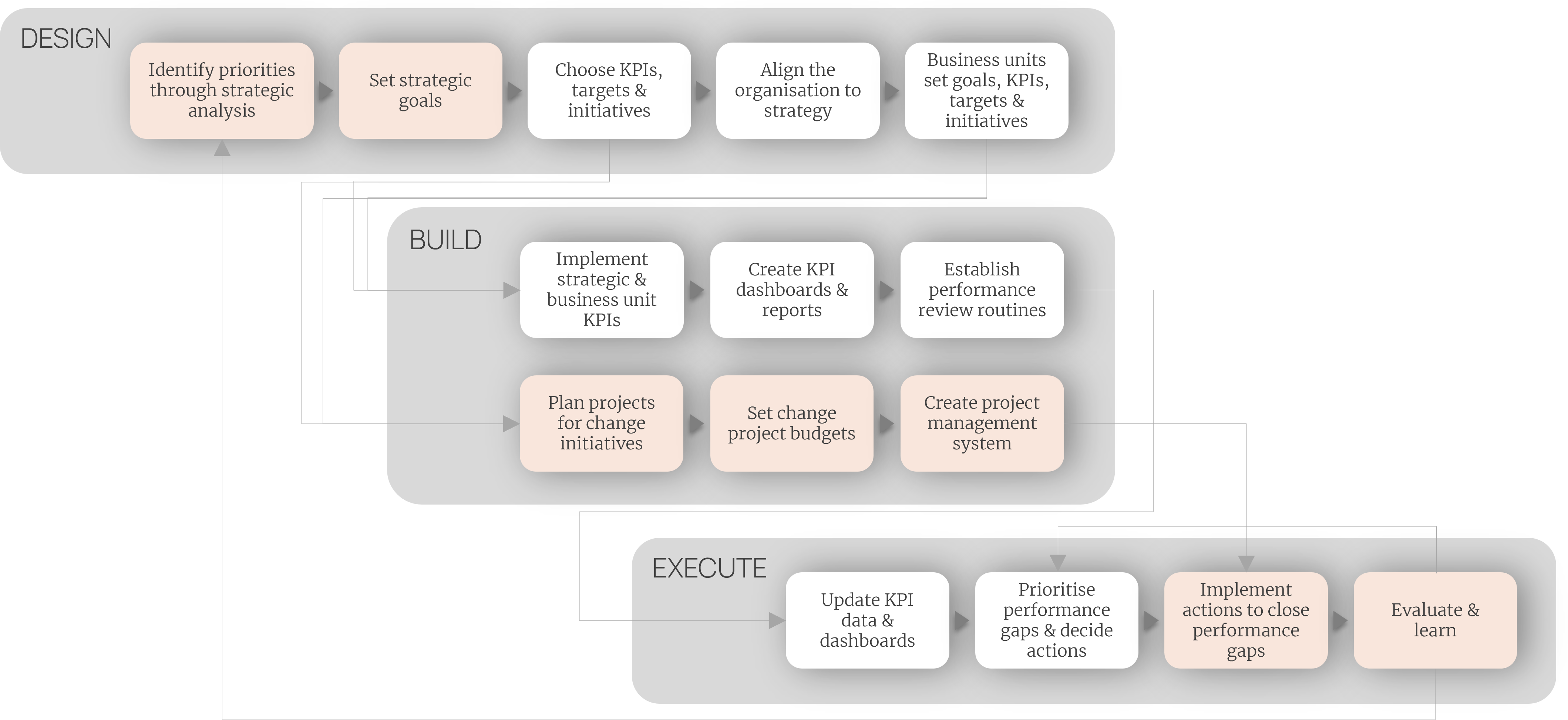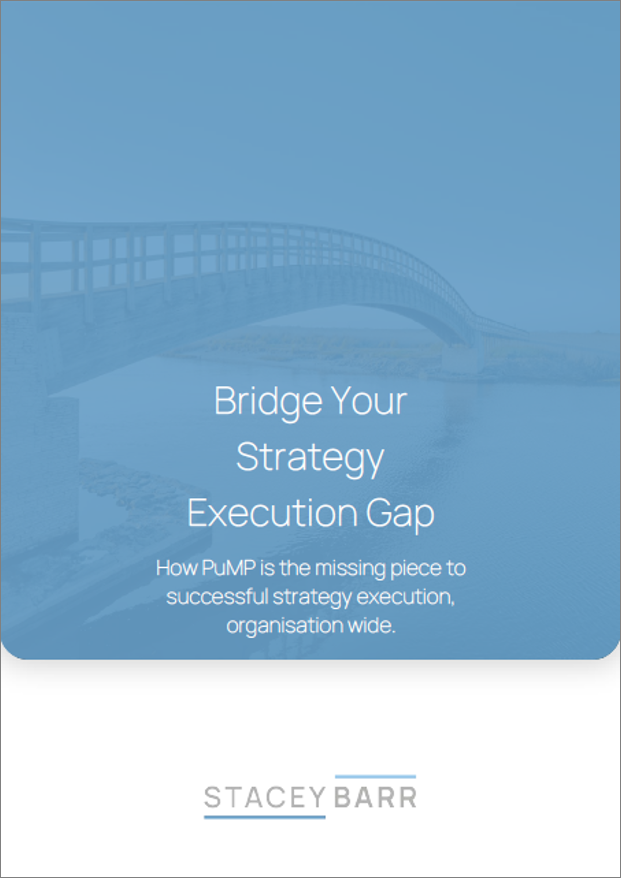Bridge Your Strategy-Execution Gap
by Stacey BarrThe reason why 60-90% of strategies will fail in execution that no-one is talking about…

When there is a disconnect between what the organisation is actually doing and what its strategic direction has planned to do, there is a strategy-execution gap. In other words, the actions taken, and the budget spent by the organisation is not achieving the strategic goals.
Organisations with a strategy-execution gap will not achieve their strategic intent and will not improve their performance in priority areas. They just waste time, money and energy – and don’t end up where they wanted to be.
Research over many years suggests that anywhere from 60-90% of organisations fail to achieve their strategic goals due to poor execution:
- In their 2016 Strategy Implementation Survey, Bridges Business Consultancy found that the failure rate was 67%
- In their Forbes.com article in 2012, Kotter International reported their studies found 70% of strategies fail to deliver
- In 1996, Robert Kaplan reported in “The Balanced Scorecard: Translating Strategy into Action” that 90% of strategies fail to be implemented
How to close the strategy-execution gap is discussed extensively in the business literature. The focus is on a range of factors affecting successful implementation of strategy, including leadership, culture, alignment, communication, engagement, change management, measurement, resource allocation, and more. But how much do each of these factors relate to your own organisation’s strategy-execution gap?
The strategy-execution gap will look different for each organisation. There isn’t a single generic way to close it. The first step to closing your strategy-execution gap is to be able to see it.
How To See Your Organisation’s Strategy-Execution Gap
Setting and executing strategy is something nearly every organisation does every year, or more often. We spend a lot of time doing it, and so it’s worthwhile to make sure it works well.
If it isn’t working well for between 60 and 90% of organisations, that means their Strategic Performance Management isn’t working well.
Every organisation has a Strategic Performance Management process. It is the series of activities that culminate in achieving desired organisational performance results.
Organisations will use a suite of approaches throughout their Strategic Performance Management process, to research, design, plan, measure, communicate, align, resource, implement, monitor and adjust their strategy.
Bridging the Strategy-Execution Gap Clue #1:
Rarely do leaders map their organisation’s Strategic Performance Management process; to deliberately choose and integrate the approaches it needs for successful strategy execution.
A strategy-execution gap happens when an organisation isn’t using a complete suite of approaches.
There isn’t a single approach complete enough to guide every activity across every part of the Strategic Performance Management process. Each approach is designed to serve a specific purpose. And approaches can be designed with different degrees of detail and practicality.
For example, the Balanced Scorecard is designed to set a strategic direction that isn’t focused solely on financial results. It gives priority to strategic performance measures, but it lacks the detail and practicality to make strategic measurement easy and meaningful.
There is, however, an abundance of approaches used around the world, in every sector and industry, to support the activities of the Strategic Performance Management process:
- Strategic planning approaches include Balanced Scorecard, Baldrige (and EFQM and ABEF), Blue Ocean Strategy, Hoshin, Logic Model, OKRs, PESTLE, Porter’s Five Forces, Scenario Planning, SWOT, and many bespoke sector-specific frameworks
- Project planning approaches include Adaptive Project Framework, Critical Chain, Critical Path Method, Kanban, PMBOK, PRINCE2, and Waterfall
- Performance improvement approaches include 5S, Agile, Business Process Management, Kaizen, Lean Six Sigma, PDCA, Scrum, SIPOC, Theory of Constrains, and Total Quality Management
- Change management approaches include ADKAR, Kotter’s 8 Steps, Lewin’s Change Theory, McKinsey 7-S, Nudge Theory, Prosci, and Satir Change Model
- Performance measurement approaches include Performance Prism and PuMP
Successful strategy execution requires that organisations blend a combination of strategy approaches, like those above, to ensure there are no gaps in their Strategic Performance Management process.
However, even with a combination of these approaches, many organisations still have a strategy-execution gap. And this is because the approaches they use fail to cover all the activities in the Strategic Performance Management process.
The Common Strategy Approaches Aren’t Enough
If we map the common strategy approaches into the Strategic Performance Management process, we are left with gaps.
- Strategic planning approaches, like Logic Model and Balanced Scorecard, map most directly into the “Identify priorities through strategic analysis” and “Set strategic goals”.
- Project management approaches, like PMBOK and PRINCE2, map most directly into “Plan projects for change initiatives”, “Set change project budgets”, and “Create project management system”.
- Performance improvement approaches, like Agile and Lean Six Sigma, map most directly into “Implement actions to close performance gaps”.
- Change management approaches map most directly into “Plan projects for change initiatives” and “Evaluate & learn”.
But after this mapping of the common strategy approaches (see the coloured steps in the flowchart below), there are still Strategic Performance Management activities that are not sufficiently supported by them.
This mapping makes the strategy-execution gap visible. Even for organisations using a suite of the common strategy approaches, their strategy-execution gap is largely related to the measurement activities of the Strategic Performance Management process.
Bridging the Strategy-Execution Gap Clue #2:
Rarely is a deliberate performance measurement approach included in an organisation’s Strategic Performance Management process.
The Most Likely Cause Of Your Strategy-Execution Gap
Surprisingly, the lack of a proper performance measurement approach is a major reason why strategy execution fails.
Approaches like the Balanced Scorecard, Logic Model and OKRs are designed to support the Design Stage of Strategic Performance Management. However, they don’t pay enough attention to exactly how to articulate clear and measurable goals, or design truly meaningful measures.
Meaningful performance measurement bridges the gap between the goals that matter and the actions that will achieve those goals. It’s easy to see this clearly, when we map the strategy approaches we use into an end-to-end Strategic Performance Management process.
Download the full White Paper “Bridge Your Strategy-Execution Gap” to get a link to the Strategic Performance Management process template, identify where your strategy-execution gap is, and how to bridge it.
Connect with Stacey
Haven’t found what you’re looking for? Want more information? Fill out the form below and I’ll get in touch with you as soon as possible.
167 Eagle Street,
Brisbane Qld 4000,
Australia
ACN: 129953635
Director: Stacey Barr






